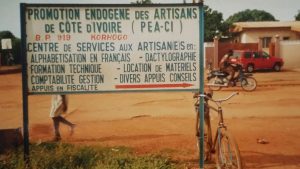
In their current formulation and practice, discontinuities between the fields of education, training and work create many problems for learners and workers of any age. Education, training and work systems operate on the assumption that an individual follows a straight and linear path from basic education, to professional training, and on to work; and that each of these processes takes place in places and spaces dedicated to either education or training or work alone. And yet, this path is far from the norm among marginalized populations in the South and North[1] and are particularly atypical of those who have never been to school or have left schooling: those without vocational training or employment opportunities, unemployed graduates, and youth and adults without basic education. These discontinuities thus create and reinforce exclusion and inequality[2] for already excluded groups.
To address these problems, we propose the notion of a Continuum between education, training and work. In contrast to the discontinuities between the existing silos of education, training and work, a Continuum involves different types of transitions from one constituting field to others, regardless of the order they follow. This perspective is also relevant for each of the three domains individually since there might be some discontinuities between each sub-component of the domains e.g., between end of primary education and the next stages of child development. The situation is the same in the fields of training and work. The approach consisting to consider education, training and work as components of a Continuum should allow those currently excluded to “travel” between any component of the Continuum at any time and in any order. Hence the main objective of promoting a Continuum approach to education, training and work is the (re)-inclusion in society of these categories of people.
It means that they have the possibility to acquire values, skills and knowledge proposed by the multiplicity of public and private stakeholders and organizations potentially positioned on the Continuum. It consequently implies that the knowledge and skills acquired during their “journey” are recognized after any “stop overs” in any of the three fields of the Continuum. The prerequisite for that journey – and its recognition – is that bridges exist between these fields. This condition being fulfilled, the Continuum is the way to facilitate the (re)-inclusion of excluded youth and adults in their socio-economic environment.[3]
Such an approach disrupts the “traditional” straight, linear and chronological progression, in which an individual passes without discontinuities from education (mostly synonymous with schooling), to training (mostly reflecting the school model, but applied to youth and adults) and work (mostly based on a stable employment model). The limits of this model have progressively appeared in the South and North, resulting in dramatic consequences in terms of exclusion and increasing inequalities between individuals, within and between countries[4].
This NORRAG project addresses problems created by the existing discontinuous model has created problems that it cannot.
[1] “North” and “South” will be used, even as we recognize the critiques of the terms.
[2] Duru-Bellat M, (2015), Social Inequality and Schooling, International Encyclopaedia of the Social and Behavioural Sciences (second edition). Retrieved from https://www.sciencedirect.com/science/article/pii/B9780080970868920154
[3] The notion of inclusion is central to the SDG ambition to Leave No One Behind (as well SDG 10 dealing with the reduction of inequalities), as well as being the theme of the 2020 Global Education Monitoring Report.
[4] Ferreira, I-A, Gisselquist, R-M, Tarp, F. On the Impact of Inequality on Growth, Human Development, and Governance (2021), WIDER Working Paper 2021/14 ; 2019 Human Development Report to focus on Inequality: https://www.wider.unu.edu/publication/impact-inequality-growth-human-development-and-governance
